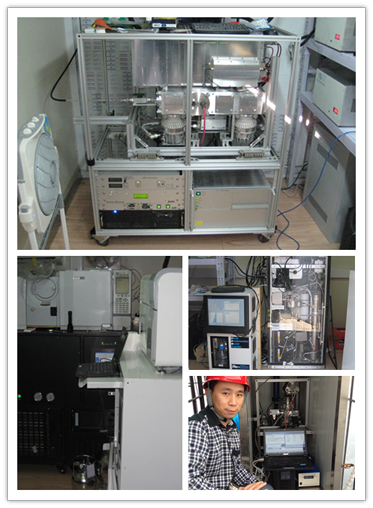China implemented strict emission control measures in Beijing and surrounding regions to ensure good air quality during the 2014 Asia-Pacific Economic Cooperation (APEC) summit. However, how these emission controls affect the chemical composition, sources and formation mechanisms of fine particles under variable meteorological conditions remains less understood. Dr. SUN Yele from the Institute of Atmospheric Physics, Chinese Academy of Sciences, and their collaborators conducted synchronous aerosol particle measurements with two aerosol mass spectrometers at two heights, i.e., ground level and 260 m on Beijing 325-m meteorological tower to investigate the variations in particulate composition, sources and size distributions in response to emission controls.
Dr. SUN found that the blue sky days during APEC (“APEC Blue”) were mainly caused by the consistently large reductions in secondary inorganic aerosol (SIA) of 61 – 67% and 51 – 57%, and in secondary organic aerosol (SOA) of 55% and 37%, at 260 m and ground level, respectively (Figure 1). These changes were mainly caused by large reductions in accumulation mode particles and by suppression of the growth of SIA and SOA by a factor of 2 – 3. Dr. SUN also observed an important role of the mountain-valley breeze circulation in mitigating particulate matter (PM) levels during APEC.

Instruments used in the aerosol particle measurements. (Photos taken in November 2014 by Dr. SUN's team)
Another important finding is the substantially different aerosol composition between ground level and 260 m. They found that the reductions of primary and secondary aerosol species at 260 m were similar despite the emission controls, whereas the concentration of primary species at the ground site showed small changes (Figure 1). These results have significant implications by highlighting the importance of aerosol particle composition measurements at high altitudes for investigating the effects of regional transport.

Figure 1. Aerosol Particle Composition before and during APEC (Figure Plotted by IAP)
Dr. SUN also found that aerosol composition change during APEC exerted a large impact on optical properties. While single-scattering albedo (SSA) remained relatively unchanged during APEC, the mass scattering efficiency of PM was decreased from 4.7m2 g-1 to 3.5 m2 g-1. They further established an empirical relationship between chemical composition and particle extinction using a multiple linear regression model. Their results showed the largest contribution of ammonium nitrate to particle extinction (35.1% and 29.3% before and during APEC, respectively), highlighting the important role of ammonium nitrate in the formation of severe haze pollution.

Figure 2. A conceptual framework on primary and secondary aerosol evolution (Figure plotted by IAP)
Dr. SUN proposed a conceptual framework for describing the evolution of primary and secondary species under the conditions with and without emission controls (Figure 2). Their results showed that regional transport contributes 66 – 80% of the PM pollution during normal two-day pollution episodes and still as much as 44 – 57% with the emission controls during APEC. Dr. SUN’s findings highlight the importance of regional atmospheric transport in the formation of severe pollution episodes in Beijing.
Overall, the studies by Sun et al. provide direct evidence that reducing the precursors of secondary aerosol over regional scales is the most effective approach to suppress the formation of secondary particulates and hence to mitigate particulate matter pollution in Beijing.
References:
Sun, Y. L., Wang, Z., Wild, O., Xu, W., Chen, C., Fu, P., Du, W., Zhou, L., Zhang, Q., Han, T., Wang, Q., Pan, X., Zheng, H., Li, J., Guo, X., Liu, J., and Worsnop, D. R.: “APEC Blue”: Secondary Aerosol Reductions from Emission Controls in Beijing, Scientific Reports, 6, 20668, 10.1038/srep20668, 2016. Link:http://www.nature.com/articles/srep20668 ; http://www.natureasia.com/zh-cn/srep/pr-highlights/10526
Xu, W. Q., Sun, Y. L., Chen, C., Du, W., Han, T. T., Wang, Q. Q., Fu, P. Q., Wang, Z. F., Zhao, X. J., Zhou, L. B., Ji, D. S., Wang, P. C., and Worsnop, D. R.: Aerosol composition, oxidation properties, and sources in Beijing: results from the 2014 Asia-Pacific Economic Cooperation summit study, Atmos. Chem. Phys., 15, 13681-13698, 10.5194/acp-15-13681-2015, 2015. Link:http://www.atmos-chem-phys.net/15/13681/2015/
Chen, C., Sun, Y. L., Xu, W. Q., Du, W., Zhou, L. B., Han, T. T., Wang, Q. Q., Fu, P. Q., Wang, Z. F., Gao, Z. Q., Zhang, Q., and Worsnop, D. R.: Characteristics and sources of submicron aerosols above the urban canopy (260 m) in Beijing, China, during the 2014 APEC summit, Atmos. Chem. Phys., 15, 12879-12895, 10.5194/acp-15-12879-2015, 2015. Link:http://www.atmos-chem-phys.net/15/12879/2015/
Han, T., Xu, W., Chen, C., Liu, X., Wang, Q., Li, J., Zhao, X., Du, W., Wang, Z., and Sun, Y.: Chemical apportionment of aerosol optical properties during the Asia-Pacific Economic Cooperation (APEC) summit in Beijing, China, Journal of Geophysical Research: Atmospheres, 120, 12281-12295, 10.1002/2015JD023918, 2015. Link:http://onlinelibrary.wiley.com/doi/10.1002/2015JD023918/full
Contact: Dr. SUN Yele, sunyele@mail.iap.ac.cn








